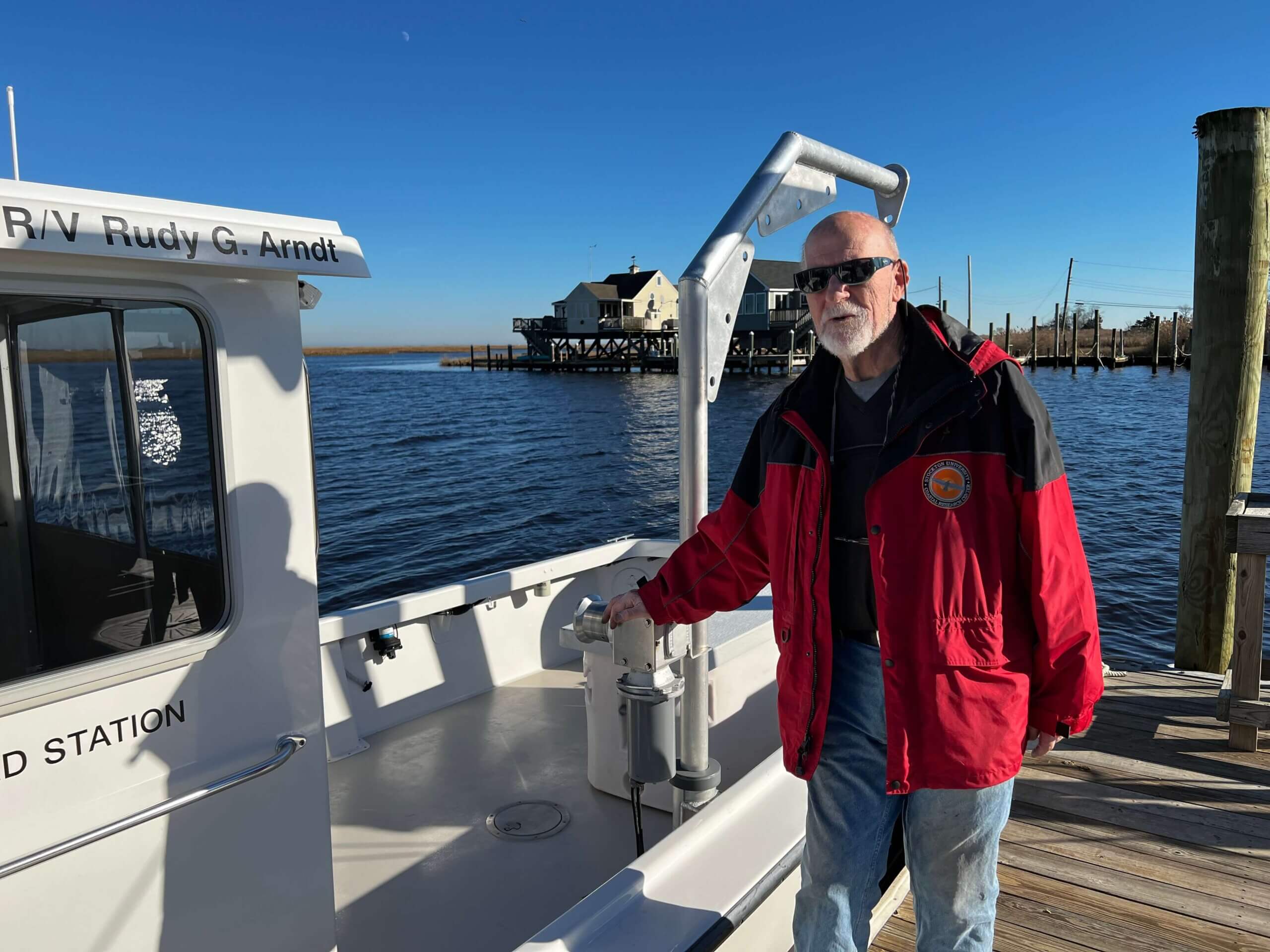PORT REPUBLIC — After 51 years at Stockton, Stewart Farrell, the area’s preeminent expert on beach replenishment, is retiring.
Farrell, 80, has been instrumental in the implementation of beach fill projects, which have continuously restored Cape May County’s biggest attraction and contributed enormously to the continued growth of the local economy.
He founded Stockton University’s Coastal Research Center and served as its director until January 2. In interviews with the Herald, he recalled a career spent out of the laboratory and on the water, a setting he decided he much preferred when studying chemistry in college.
Introducing the Beach Fill
Routine beach fills are a relatively new phenomenon. In the late 1970’s, as Farrell explained, the U.S. Army Corps of Engineers got involved, completing its first big project in North Miami Beach, Florida in 1978.
“10 million yards were pumped on there and they restored the place. I mean, it was phenomenal the benefits that accrued to the community from that beach fill. And its success spawned other copycats,” Farrell said.
Farrell said Bernard Moore, an engineer who was running the state’s coastal engineering division, which was in charge of building state projects on the coast, spent a lot of time talking with him about the erosion problems the state was facing. Previously in some parts of the state, they had tried to fend off erosion with rock jetties, without much sustained success.
After the North Miami Beach project revitalized the towns economy and was a smash hit, Farrell and Moore started talking about pumping sand. The state funded several replenishment projects in the late 70s, and through the mid 80’s, until the feds came with an offer they could not refuse.
“The federal government stepped in and said, ‘look, we’ll do it. We’ll pay 65% of the cost and you guys have to split the rest among yourselves, as the non-federal sponsors, and we’ll deal with it for 50 years. And Mr. Moore said, I’m all in,” Farrell said. “They realized, hey, if the feds are going to pay 65 cents on a dollar project cost, you can’t beat that with a stick. I mean, it’s a pretty good deal. Why don’t we do this? … It was a fabulous deal.”
The Value of the Sand
Cape May County’s first federally funded project was in Ocean City, after the Halloween storm of 1991. Farrell said the benefit of the work was quickly apparent.
“After the ‘91 Halloween storm, they got their heads handed to them in the middle of the island. And then they did the federal project. And in 1992, a December storm was worse. No damage,” Farrell recalled. “They said, ‘hey that was pretty good. We got our money back in six months.”’
In Avalon, after an early replenishment project in 1987, the value of a replenishment was plainly put in black and white.
According to Farrell, a beachfront home toward the borough’s north end sold for $85,000 in March 1987. After a replenishment project that spring, the same home sold in the fall for $365,000.
“The guy that bought it did nothing to the house, didn’t even paint the concrete blocks,” Farrell said.
Still, there was opposition in different towns from people who did not think the projects were necessary and complained that the dunes were inconvenient to walk over or obstructed their view. It wasn’t until after Hurricane Sandy wreaked havoc on the New Jersey coast in 2012 that Farrell said he sensed widespread support for the work.
“The leadership — municipal officials and county officials — after Hurricane Sandy, they all kind of woke up and started smelling the roses. I mean, they really did. They got serious about resilience, mitigation and planning for the future. All three things they started really focusing on after 2012,” Farrell said.
A Jersey Kid
Growing up in Interlaken, Monmouth County, Farrell said he always had a connection to New Jersey’s beaches, evidenced by a 1944 photo he has of himself on the beach in the wintertime.
“We went to the beach daily in the summer. So, I spent an awful lot of time there,” Farrell said.
He said he wasn’t surfing, that was more of a Hawaii thing in the 50’s, but he was in the ocean riding the waves anyway.
“We didn’t have surfboards growing up. We had the Hodgman inflatable floats, the rafts, and so that’s what we rode back in the 1950s,” he recalled.
However, he didn’t have a particular fascination with the marine science growing up, he was more the typical beach bum.
“I was sitting on the beach, roasting in the sun or swimming in the ocean,” Farrell said. “Sure, it laid the groundwork. I mean, I kind of understood what waves and tides and currents were, but that was about as far as it got.
Farrell graduated from Asbury Park High School and went on to study at the University of Massachusetts Amherst, eventually earning a Ph.D. He was an original faculty member at Stockton, where he began working as a 28-year-old. In 1987, he founded the Coastal Research Center, whose clients now include the DEP, the state’s transportation department and many coastal towns.
“I was big with the towns. I really love working with the towns,” Farrell said.
The Future of the Beaches and the Islands
Climate change is real, Farrell says. There is plenty of evidence of it. One of his favorite examples of its impacts comes from a Catholic church, on the harbor in Norfolk, Virginia, which now schedules mass to avoid high tide.
“At high tide, with the spring tide especially, there’s three or four inches of water in the street and they don’t want to go to church walking through a half a foot of water,” Farrell said. “They literally schedule mass around it. In other words, if high tide is at 11 a.m. Sunday, well okay, we’ll have mass at 9:00, and we’ll miss it. Or we’ll have mass at 2:00.”
Still, he isn’t pessimistic. Farrell owns a place in Cape May Point, which is a primarily a seasonal residence for him and his wife. He said for someone his age, or even several years younger, buying at the Jersey shore is not a mistake.
He said he would advise people to be aware of the future risks, but enjoy every minute in the meantime, as he plans to do himself.
“They should be aware. I mean, the story is out. I’m not the only one preaching it. Okay, take it all in. But next year, 10 years from now, it’s all going to be pretty much the same. Enjoy the hell out of it. I intend to. I have a place in Cape May Point. I’m going to be there most of the summer. My little electric cart will be down there at Pittsburgh Avenue almost every day.”
Higher elevation always makes flooding and storm damage less concerning, but even in low-lying West Wildwood, there is still time, Farrell estimates.
At some point, Farrell warns that town will suffer the same fate as some of Staten Island’s Midland Beach neighborhood after Hurricane Sandy devastated the area. Homes were demolished and several properties were acquired by the government. Where the houses were, the government installed a park and made way for an infrastructure project which enhanced a natural watershed.
To avoid that fate, Farrell said West Wildwood has two other options. They can either raise the footprint five or 10 feet, by bringing in a lot of dirt, or build a tall wall around the town and pump stormwater out, similar to what’s done in New Orleans.
The only option that doesn’t present a seemingly inconceivable expense is walking away. But still, Farrell balked at offering that suggestion. Perhaps it’s the beach loving kid from Interlaken in him prevailing over the reasoned scientist. His advice is to enjoy every minute you can and didn’t agree it would be foolish purchasing property.
“If I was seven years old, I wouldn’t, no. If you’re in your 60s, West Wildwood will survive your lifetime,” Farrell said. “That’s why I tell anybody locally… Will it be the same? Maybe not. Will there be major storm events that do damage? Yes.”
What’s Next, Doc?
In North Wildwood, Farrell sees more work to be done. He said he has plans to continue consulting with that city after leaving Stockton. He said he also has interest from Avalon and he received a call from a Cape May official, inquiring about working with him there.
Farrell also said he has been called recently as an expert witness, mostly to testify for the state in trials involving litigation brought by property owners who owned private beaches that were acquired using eminent domain by then-Governor Chris Christie in the wake of Hurricane Sandy.
He said he’s earning good money and is going to continue his role in the litigation after retiring from Stockton. Farrell said his work with the university is over and feels the research center he founded is in more than capable hands.
“I’m not keeping a foot in the door here. I’m done. It’s over. I’m done. Goodbye. You’re on your own,” he said. “I’ve made a lot of friends and one or two enemies here and there for sure. But nonetheless, my goal was to have something that survives…. I could’ve stayed till I dropped dead. But why?”
Farrell certainly made a few friends. Look not further than his recent retirement party to prove it. Representatives of the DEP, the DOT, the Army Corps, local communities and of course the university were amongst the guests celebrating his distinguished career. One guest even flew in from Texas to honor Farrell at a Smithville restaurant.
Farrell is a young looking 80, still vibrant, full of energy and passion about his field. It almost seems puzzling that he is retiring, when clearly he still has so much he could offer.
But, as he recalled his disappointment when his college classmates seemed more interested in doing lab work than racing cars on Lake Michigan, a weekend activity he preferred to academia, you can understand why he’s retiring. It’s because he’s still got a lot of living to do.
And on that note, Farrell hopped into his electric Ford Mustang Mach-E and sped off into retirement.
To contact Shay Roddy, email sroddy@cmcherald.com or call (609) 886-8600 ext. 142.







